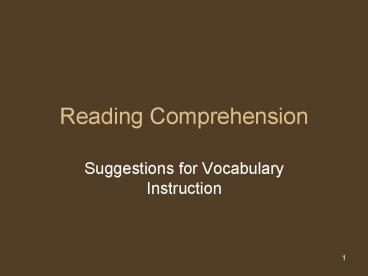Reading Comprehension - PowerPoint PPT Presentation
1 / 22
Title:
Reading Comprehension
Description:
Reading Comprehension Suggestions for Vocabulary Instruction Rationale Research has shown that many children who read at grade level in grade 3 will not automatically ... – PowerPoint PPT presentation
Number of Views:2734
Avg rating:3.0/5.0
Title: Reading Comprehension
1
Reading Comprehension
- Suggestions for Vocabulary Instruction
2
Rationale
- Research has shown that many children who read at
grade level in grade 3 will not automatically
become proficient comprehenders in later grades.
Therefore, teachers must teach comprehension
explicitly, beginning in the primary grades and
continuing through high school (RAND Reading
Study Group, 2002).
3
Content Area Reading Research
- Content literacy can be defined as the ability to
use reading and writing for the acquisition of
new content in a given discipline (McKenna
Robinson, 1990, p. 184).
4
Important Concept
- Its not doing more
- its doing things differently.
5
Strategic Teaching
- Strategic teaching is the process of
incorporating purposeful planning, multiple
strategies, connected strategies, and explicit
instruction to maximize the understanding and
retention of content material.
6
Strategic Teaching
- An on-going practice
- Not a series of stand-alone lessons or random
activities sprinkled throughout lesson plans
7
Strategic Teaching
- Strategic teaching incorporates before, during,
and after reading strategies as well as a variety
of vocabulary development and writing strategies.
The strategies a teacher chooses will depend on
the purpose of the lesson, the nature of the
material being studied, and student data.
8
Vocabulary Development
- Vocabulary knowledge is critical to reading
comprehension. If a word is decoded and
pronounced but the meaning is not recognized,
comprehension will be impaired (Stanovich, 1993). - A number of studies indicate that reading
comprehension requires a high level of word
knowledge- higher than the level achieved by many
types of vocabulary instruction. The implication
is that teachers should augment traditional
methods of vocabulary instruction with more
intensive instruction aimed at producing richer,
deeper word knowledge (Nagy, 2002) - Think about the following
- HOW DO YOU TEACH VOCABULARY?
9
Vocabulary Development Research
- Most vocabulary is learned indirectly.
- Some vocabulary must be taught directly.
- Students have 4 vocabularies listening,
speaking, reading, and writing. - Struggling students large listening
vocabularies - Proficient students know 4 times as many words as
struggling students.
10
Indirect Word Learning
- Students learn word meanings indirectly in three
ways - 1. They engage daily in oral language.
- 2. They listen to adults read to them.
- 3. They read extensively on their own.
11
Specific Word Instruction
- Specific word instruction can deepen students
knowledge of word meanings. - Teaching specific words before reading helps both
vocabulary learning and reading comprehension. - Extended instruction that promotes active
engagement with vocabulary improves word
learning. - Repeated exposure to vocabulary in many contexts
aids word learning.
12
Responsibility of Content Area Teachers
- To help students learn and understand the
vocabulary of the discipline they teach - To apply the correct label to the new concepts
they meet - Avoid look-it-up, use-it-in-a-sentence,
take-a-quiz-on-Friday strategy - To show students that common words are often used
differently in different subject areas
13
Integration and Repetition
- Words must be hooked onto experiences in our
lives. - Research (Nagy, 1998) tells us that effective
vocabulary instruction must include integration
and repetition and have meaning in our lives.
14
Vocabulary Research
- . . . By no means will all unfamiliar words
encountered in reading be learned, and those that
are learned will require multiple encounters with
them before learning is accomplished (Beck,
McKeown, Kucan, 2002).
15
Multiple Exposures
- Words are learned incrementally through multiple
exposures (Stahl, 2003). - As many as 4 encounters with a word do not
reliably improve reading comprehension skills a
minimum of 12 exposures is suggested.
16
Teaching Vocabulary in the Classroom
- An effective vocabulary development program for
secondary students should include 3 main
strategies - Promoting broad and intensive reading and oral
discussions - Encouraging students to experiment with words
- Explicitly teaching word meanings and
word-learning strategies
17
Knowledge Ratings
- purpose is to create an awareness of known and
unknown words - a pre-reading activity
- gives students and teacher an idea of which words
need attention and which ones dont
18
Connecting the Visual to the Verbal
- Examples Vocabulary Word Maps, Quadrant Cards,
Vocabulary Squares, Verbal/Visual Word
Association - Graphic organizers
- Allows students to pictorially link words with
their meanings - Time-tested way for students to learn new words
more deeply
19
Sketching Vocabulary
- Draw a picture, symbol, or icon for the following
words - Love
- Religion
- Divorce
- Egregious
- Forsade
20
- Teaching vocabulary involves
- rich discussions about the meaning(s) of
unfamiliar words - making connections between new words and familiar
concepts - using words in context
- analyzing word parts and
- active student engagement.
21
Selection Criteria
- Choose the words you teach carefully. Teach
words that are important for understanding a
concept or the text. Teach words that students
are likely to see and use again and again. - Provide instruction for words that are
particularly difficult for your students.
22
- Final Note on Vocabulary
- Please do not have students copy definitions
directly from a dictionary or textbook glossary.
This is a passive learning activity that rarely
leads to students having ownership of new
vocabulary.

